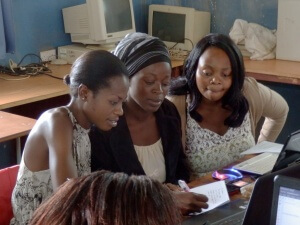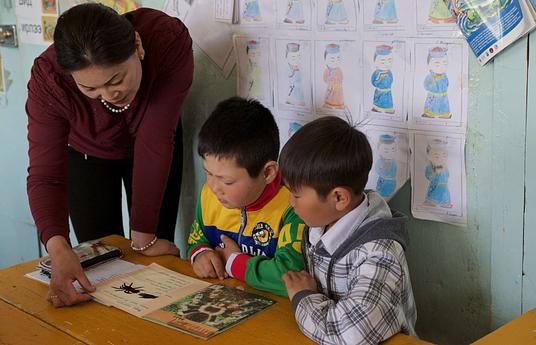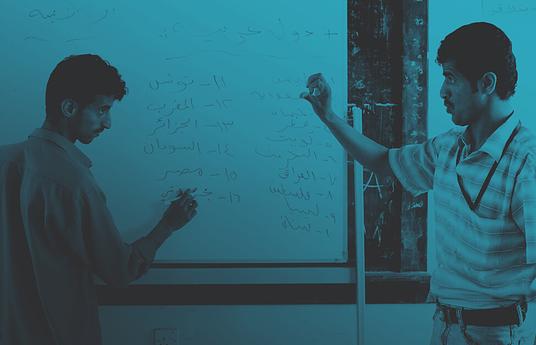The right type of teacher professional development (TPD) is one of the most effective interventions to improve student learning and wellbeing. It’s second only to Teaching at the Right Level (TaRL), though to effectively teach at the right level, TPD is needed. Even before COVID-19 brought about disruptions to schools and in-person teaching, there has been increasing interest in the potential for technology to enhance effective, sustainable, and scalable teacher professional development.
Five cross-cutting principles need to be taken into account when using technology for TPD in low-resource contexts.
Firstly, for technology to effectively support TPD in low-resource contexts, the TPD to be supported needs to be effective TPD itself.
That is to say, it has to support TPD practices that are demonstrably effective in low-resource settings. This includes practices such as encouraging peer interaction among teachers, developing cycles of reflection-trial-refinement, and building on what teachers already know. Unfortunately — and we cannot emphasise this enough — there is a gap between evidence and practice in teacher professional development. Without the right foundations, no amount of technology use will make teacher professional development effective. Once you have an effective model, you can then look at how to utilise technology. With a team of researchers within the EdTech Hub, we spent the last month reviewing 700+ digital tools that can support TPD. We selected effective tools and categorised them into how they support TPD. We found that some categories have a wide selection of available tools, while others don’t have dedicated tools at all. For example, while there are many tools that can be used for communication and peer interaction, there were no tools dedicated to supporting reflection-trial-refinement. This is not to say that the technology does not exist — existing technologies can be adapted and used to support even those characteristics of effective TPD where dedicated tools are lacking.
 |  |
Secondly, the choice of technology has to fit the existing infrastructure.
For example, this can include using offline tools such as Kolibri — featured in the HundrED 2021 Global Collection — in settings where access to data and connectivity is low or not existent. The Roger Federer Foundation adapted an openly licensed TPD curriculum — OER4Schools — to support unqualified teachers in Zambian community schools. Through the iAct programme, they loaded this TPD material onto offline tablets that the teachers could use in their schools. The programme reached more than 5,000 teachers within the first two years. But not everyone will be offline all of the time — in emergency settings, non-governmental organisations (NGOs) sometimes form agreements with telecommunications providers to provide data packages for teachers. The key takeaway is that if you’re designing a TPD intervention that teachers can actually benefit from, the technology you use has to fit within the currently existing technological infrastructure — as opposed to an ‘aspirational’ infrastructure that may or may not be available in the future.
Thirdly, the choice of technology has to offer sufficient incentives for teachers to want to use it, i.e., where teachers can see the benefit and will therefore be willing to learn how to use the tool if necessary.
Too often, innovators have exciting ideas about new tools to support teachers and assume that teachers will use the tools just because they are effective and straightforward. In these cases, innovators are too often disappointed when teachers instead prefer to use the (perhaps less effective) tools that they already use in their daily lives. All too often, teachers are seen as ‘willing app testers’ when, in reality, teachers first and foremost have a duty to be effective teachers for their students. If teachers have to learn a new skill in order to use the technology or have to change their existing practices, you will need to make a convincing case for why your intended audience (teachers) should start using your tools — otherwise, you might find resistance to your innovation, ultimately leading to limited uptake for the intervention.
Fourthly, your use of technology has to be specific. Educational technology (EdTech) is not good for solving general challenges. It is good for solving specific challenges.
For example, it’s not effective to say, “we’re going to use technology to improve TPD within this city.” Instead, think about the specific challenge with TPD and consider whether technology offers the best option to address it. Perhaps you realise there’s a challenge with teachers forming specialist Communities of Practice (CoP) because distances are too far to travel. You could use technology to bridge the distance gap by organising specialist Communities of Practice digitally, for example, over WhatsApp.
Finally, make sure the intervention can scale. Sometimes we say that we should use technology that can scale; however, in many ways, this means using technology that has already scaled.
Equipping all the teachers in one school with a smartphone to access TPD resources might work effectively in that school, but will not scale right now, because you cannot equip each teacher with a smartphone. Consider what’s possible. For example, if you use non-smartphones, aspects of your intervention may still work.
Moreover, some interventions have used a one-tablet-per-school approach (iAct). Equipping schools with one tablet each can be much more cost-effective than equipping each teacher with a device and can lead to effective TPD outcomes. Tablets can be loaded with TPD material and used in school-based teacher learning groups to stimulate learning. In particular, we know that watching video clips of actual classroom teaching plays a significant role in stimulating reflection. Moreover, the one tablet available can be used in combination with messaging to non-smartphones, covering different aspects of the intervention.
More evidence is still needed on the effectiveness of technology-supported TPD compared with TPD delivered without technology in low-resource contexts. Still, for now, the successes of technology-enabled TPD interventions offer reason to be hopeful about the potentially enabling effects of technology. Technology-supported TPD interventions have the potential to catalyse the quality, equitability, and effectiveness of TPD in low-resource contexts. To do so, we need to ensure that the technology used:
- supports effective pedagogic practices;
- fits within the existing digital infrastructure;
- matches the teachers’ levels of digital literacy;
- addresses a specific challenge; and is scalable.
Importantly, technology can increase equitability by supporting the most marginalised teacher in their professional development, and by reducing the gaps between teachers in more privileged and less privileged areas.
References for further reading
This bibliography is available digitally in our evidence library. All items are freely available for download.
- OER4Schools. (n.d.). Retrieved May 27, 2020, from http://oer.educ.cam.ac.uk/wiki/OER4Schools. (details)
- Allier-Gagneur, Z., McBurnie, C., & Haßler, B. (2020). Characteristics of effective teacher education in low- and middle-income countries: a summary of evidence on teacher education (HDR10B) (EdTech Hub Helpdesk Response No. 10B). https://doi.org/10.5281/zenodo.3873462. Available under Creative Commons Attribution 4.0 International. (details)
- Evans, D. K., & Popova, A. (2016). What Really Works to Improve Learning in Developing Countries? An Analysis of Divergent Findings in Systematic Reviews [World Bank Research Observer]. The World Bank Research Observer, 31(2), 242–270. https://doi.org/10.1093/wbro/lkw004. Available from https://academic.oup.com/wbro/article-lookup/doi/10.1093/wbro/lkw004. (details)
- Haßler, B., Hennessy, S., & Hofmann, R. (2018). Sustaining and Scaling Pedagogic Innovation in Sub-Saharan Africa: Grounded Insights For Teacher Professional Development. 5(1). (details)
- Popova, A., Evans, D. K., Breeding, M. E., & Arancibia, V. (2018). Global Landscape of Teacher Professional Development Programs: The Gap between Evidence and Practice. Population and Development Review, 1(117), 42. (details)
- Roger Federer Foundation. (2018). Annual Report. Roger Federer Foundation -. https://rogerfedererfoundation.org/assets/publication/pdf/annual-reports/Roger_Federer_Foundation_Annual_Report_2018.pdf. (details)




